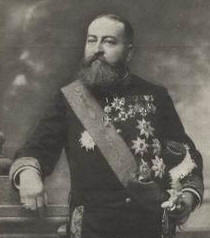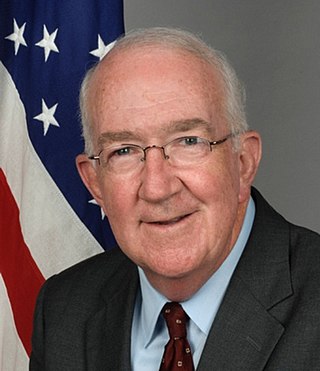
Carlo Azeglio Ciampi was an Italian politician, statesman and banker who was the prime minister of Italy from 1993 to 1994 and the president of Italy from 1999 to 2006.

The Most Distinguished Order of Saint Michael and Saint George is a British order of chivalry founded on 28 April 1818 by George, Prince of Wales, while he was acting as prince regent for his father, King George III. It is named in honour of two military saints, Michael and George.

The Equestrian Order of the Holy Sepulchre of Jerusalem, also called the Order of the Holy Sepulchre or Knights of the Holy Sepulchre, is a Catholic order of knighthood under the protection of the Holy See. The Pope is the sovereign of the order. The order creates canons as well as knights, with the primary mission to "support the Christian presence in the Holy Land". It is an internationally recognised order of chivalry. The order today is estimated to have some 30,000 knights and dames in 60 lieutenancies around the world. The Cardinal Grand Master has been Fernando Filoni since 2019, and the Latin Patriarch of Jerusalem is ex officio the Order's Grand Prior. Its headquarters are situated at the Palazzo Della Rovere and its official church in Sant'Onofrio al Gianicolo, both in Rome, close to Vatican City. In 1994, Pope John Paul II declared the Virgin Mary as the order's patron saint under the title "Blessed Virgin Mary, Queen of Palestine".

The Pontifical Equestrian Order of St. Gregory the Great was established on 1 September 1831, by Pope Gregory XVI, seven months after his election as Pope.

The Military Order of Our Lord Jesus Christ is the former order of Knights Templar as it was reconstituted in Portugal. Before 1910, it was known as the Royal Military Order of Our Lord Jesus Christ, and the Order of the Knights of Our Lord Jesus Christ. It was founded in 1319, with the protection of King Denis of Portugal, after the Templars were abolished on 22 March 1312 by the papal bull, Vox in excelso, issued by Pope Clement V. King Denis refused to pursue and persecute the former knights as had occurred in most of the other sovereign states under the political influence of the Catholic Church.

The Supreme Order of the Most Holy Annunciation is a Roman Catholic order of chivalry, originating in Savoy. It eventually was the pinnacle of the honours system in the Kingdom of Italy, which ceased to be a national order when the kingdom became a republic in 1946. Today, the order continues as a dynastic order under the jurisdiction of the Head of the House of Savoy.

The Order of the Golden Spur, officially known also as the Order of the Golden Militia, is a papal order of knighthood conferred upon those who have rendered distinguished service in propagating the Catholic faith, or who have contributed to the glory of the Church, either by feat of arms, by writings, or by other illustrious acts. With the death in 2019 of the last remaining knight, Grand Duke Jean of Luxembourg, the order is considered dormant.

Christopher Tostrup Paus, Count of Paus was a Norwegian landowner, heir to the timber firm Tostrup & Mathiesen, papal chamberlain and count, known as philanthropist, art collector and socialite in the late 19th and early 20th centuries. He inherited a fortune from his grandfather, timber magnate Christopher Tostrup, and lived for decades in Rome; in 1923 he bought the estate Herresta in Sweden which is still owned by descendants of his cousin Herman Paus who was married to a granddaughter of Leo Tolstoy. He gave large donations to museums in Scandinavia and to the Catholic Church, notably the Paus collection of classical sculpture that now forms part of the National Museum of Norway. Paus was considered "the founder of the National Gallery's antiquities collection" by Harry Fett. A convert to Catholicism, he was appointed as a papal chamberlain by Pope Benedict XV in 1921 and conferred the title of count by Pope Pius XI in 1923. He was the recipient of numerous papal and Scandinavian honours. He was a first cousin once removed of playwright Henrik Ibsen and was the only Ibsen relative to visit Ibsen during his decades-long exile when he wrote his most famous works.

The Order of Saints Maurice and Lazarus is a Roman Catholic dynastic order of knighthood bestowed by the royal House of Savoy. It is the second-oldest order of knighthood in the world, tracing its lineage to AD 1098, and it is one of the rare orders of knighthood recognized by papal bull, in this case by Pope Gregory XIII. In that bull, Pope Gregory XIII bestowed upon Emmanuel Philibert, Duke of Savoy and his Savoy successors, the right to confer this knighthood in perpetuity. The Grand Master is Prince Emanuele Filiberto of Savoy, Prince of Venice, also known as the Duke of Savoy, the grandson of the last King of Italy, Umberto II. However, Emanuele Filiberto's cousin twice removed Prince Aimone, Duke of Aosta claims to be grand master as his father claimed to be head of the house of Savoy.

The Pontifical Equestrian Order of Saint Sylvester, sometimes referred to as the Sylvestrine Order, or the Pontifical Order of Pope Saint Sylvester, is one of five orders of knighthood awarded directly by the Pope as Supreme Pontiff and head of the Catholic Church and as the Head of State of Vatican City. It is intended to honour Catholic laypeople who are actively involved in the life of the Church, particularly as it is exemplified in the exercise of their professional duties and mastership of the different arts.

The Sacred Military Constantinian Order of Saint George, also historically referred to as the Imperial Constantinian Order of Saint George and the Order of the Constantinian Angelic Knights of Saint George, is a dynastic order of knighthood of the House of Bourbon-Two Sicilies. Currently, the grand magistry of the order is disputed among the two claimants to the headship of the formerly reigning House of Bourbon-Two Sicilies as heirs of the House of Farnese, namely Prince Pedro and Prince Carlo. The order was one of the rare orders confirmed as a religious-military order in the papal bull Militantis Ecclesiae in 1718, owing to a notable success in liberating Christians in the Peloponnese. Together with the Sovereign Military Order of Malta, it is one of a small number of Catholic orders that still have this status today. It is not an order of chivalry under the patronage of the Holy See, but its membership is restricted to practising Catholics.

The Capture of Rome occurred on 20 September 1870, as forces of the Kingdom of Italy took control of the city and of the Papal States. After a plebiscite held on 2 October 1870, Rome was officially made capital of Italy on 3 February 1871, completing the unification of Italy (Risorgimento).

Jules Henri Ghislain Marie, Baron de Trooz was a Belgian Catholic Party politician.

The Order of the Immaculate Conception of Vila Viçosa is a dynastic order of knighthood of the House of Braganza, the former Portuguese Royal Family. The current Grand Master of the Order is Duarte Pio, Duke of Braganza, the Head of the House of Braganza.

A collar, also known as collar of an order, is an ornate chain, often made of gold and enamel, and set with precious stones, which is worn about the neck as a symbol of membership in various chivalric orders. It is a particular form of the livery collar, the grandest form of the widespread phenomenon of livery in the Middle Ages and Early Modern Period. Orders which have several grades often reserve the collar for the highest grade. The links of the chain are usually composed of symbols of the order, and the badge of the order normally hangs down in front. Sometimes the badge is referred to by what is depicted on it; for instance, the badge that hangs from the chain of the Order of the Garter is referred to as "the George".

The Order of Merit is the order of merit of the Sovereign Military Order of Malta, established in 1920. It is awarded to recipients who have brought honour to the Sovereign Military Order of Malta, promoted Christian values and for charity as defined by the Roman Catholic Church. Unlike Knights or Dames of the Order of Malta, those decorated with the Order are not invested in a religious ceremony, do not swear any oath or make any religious commitment. It may therefore be bestowed upon non-Catholics. Conferees include prominent statesmen, such as Presidents Ronald Reagan, who received it while still in office, and George H. W. Bush.
Precedence signifies the right to enjoy a prerogative of honor before other persons; for example, to have the most distinguished place in a procession, a ceremony, or an assembly, to have the right to express an opinion, cast a vote, or append a signature before others, to perform the most honorable offices.
The orders, decorations, and medals of the Holy See include titles, chivalric orders, distinctions and medals honoured by the Holy See, with the Pope as the fount of honour, for deeds and merits of their recipients to the benefit of the Holy See, the Catholic Church, or their respective communities, societies, nations and the world at large.

Mercedes Arrastía Vda. de Tuason in Lubao, Pampanga, is a Philippine diplomat and former ambassador to the Holy See. An alumnus of Saint Scholastica's Catholic college in Manila, Tuason has served in the field of nutritional sciences and was appointed plenipotentiary to the Holy See in 2009.

Kenneth Francis Hackett served as the United States Ambassador to the Holy See from August 2013 until January 2017. He was previously president of Catholic Relief Services (CRS).































